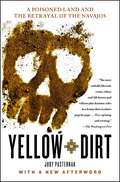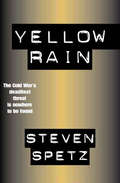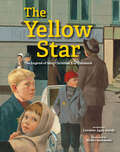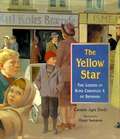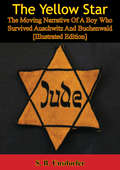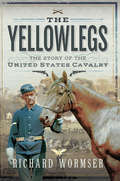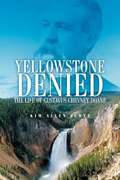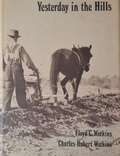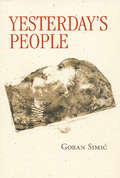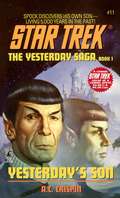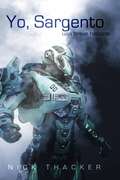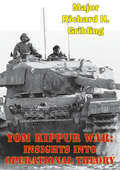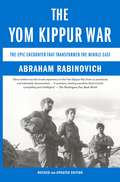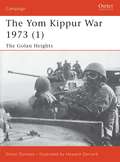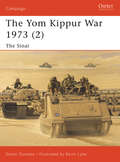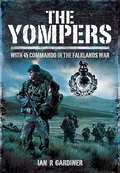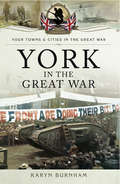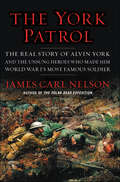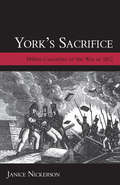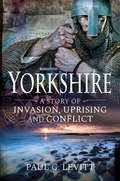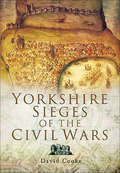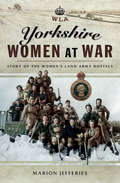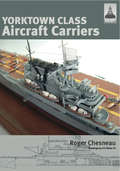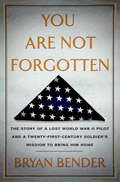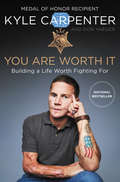- Table View
- List View
Yellow Dirt
by Judy PasternakWINNER OF THE J. ANTHONY LUKAS WORK-IN-PROGRESS AWARD Atop a craggy mesa in the northern reaches of the Navajo reservation lies what was once a world-class uranium mine called Monument No. 2. Discovered in the 1940s--during the government's desperate press to build nuclear weapons--the mesa's tremendous lode would forever change the lives of the hundreds of Native Americans who labored there and of their families, including many who dwelled in the valley below for generations afterward. Yellow Dirt offers readers a window into a dark chapter of modern history that still reverberates today. From the 1940s into the early twenty-first century, the United States knowingly used and discarded an entire tribe for the sake of atomic bombs. Secretly, during the days of the Manhattan Project and then in a frenzy during the Cold War, the government bought up all the uranium that could be mined from the hundreds of rich deposits entombed under the sagebrush plains and sandstone cliffs. Despite warnings from physicians and scientists that long-term exposure could be harmful, even fatal, thousands of miners would work there unprotected. A second set of warnings emerged about the environmental impact. Yet even now, long after the uranium boom ended, and long after national security could be cited as a consideration, many residents are still surrounded by contaminated air, water, and soil. The radioactive "yellow dirt" has ended up in their drinking supplies, in their walls and floors, in their playgrounds, in their bread ovens, in their churches, and even in their garbage dumps. And they are still dying. Transporting readers into a little-known country-within-a-country, award-winning journalist Judy Pasternak gives rare voice to Navajo perceptions of the world, their own complicated involvement with uranium mining, and their political coming-of-age. Along the way, their fates intertwine with decisions made in Washington, D.C., in the Navajo capital of Window Rock, and in the Western border towns where swashbuckling mining men trained their sights on the fortunes they could wrest from tribal land, successfully pressuring the government into letting them do it their way. Yellow Dirt powerfully chronicles both a scandal of neglect and the Navajos' long fight for justice. Few had heard of this shameful legacy until Pasternak revealed it in a prize-winning Los Angeles Times series that galvanized a powerful congressman and a famous prosecutor to press for redress and repair of the grievous damage. In this expanded account, she provides gripping new details, weaving the personal and the political into a tale of betrayal, of willful negligence, and, ultimately, of reckoning.
Yellow Rain
by Steven SpetzA mysterious—and lethal—chemical weapon goes missing in this Cold War thriller of nonstop intrigue and suspense. When an Afghan village becomes paralyzed by the Soviets&’ new warfare, and a thick nerve gas suffocates innocent people, rumors of a deadly weapon find their way to the Pentagon—and into the hands of Lieutenant Colonel Mark Schad. Along with his three-man team, Lieutenant Colonel Schad will lead one of the riskiest covert operations known to the US Department of Defense in order to find one unexploded cylinder of Yellow Rain. But are these men up against something much greater than American intelligence is prepared to face?
The Yellow Star: The Legend of King Christian X of Denmark
by Carmen Agra DeedyWithout the yellow star to point them out, the Jews looked like any other Danes. In 1940, Nazis occupied Denmark and King Christian X, beloved amongst his people, had to find some way to resist their overwhelming power. When the order went out that all Jews must wear a yellow star on their clothes, the king had an idea that might just work. But it would take the faith and commitment of all Danes.In this retelling of a World War II legend, New York Times best-selling author Carmen Agra Deedy poignantly remind us of the power of a good, wise leader. Paired with Henri Sørensen's arresting full-color portraits, this is a powerful and dignified story of heroic justice.
The Yellow Star: The Legend of King Christian X of Denmark
by Carmen Agra Deedy Henri SorensenWithout the yellow star to point them out, the Jews looked like any other Danes. For centuries, the Star of David was a symbol of Jewish pride. But during World War II, Nazis used the star to segregate and terrorize the Jewish people. Except in Denmark. When Nazi soldiers occupied his country, King Christian X of Denmark committed himself to keeping all Danes safe from harm. The bravery of the Danes and their king during that dangerous time has inspired many legends. The most enduring is the legend of the yellow star, which symbolizes the loyalty and fearless spirit of the king and his people. Award-winning author and storyteller Carmen Deedy has poignantly recreated this legend, which is accompanied by Danish illustrator Henri Sørensen's arresting full-color portraits. The result is a powerful and dignified story of heroic justice, a story for all people and all times.
The Yellow Star: The Moving Narrative Of A Boy Who Survived Auschwitz And Buchenwald [Illustrated Edition]
by S. B. UnsdorferIncludes 204 photos, plans and maps illustrating The Holocaust"Simcha Bunem Unsdorfer was the son of a well-known rabbi in Bratislava, the mother community for the Jewish population of Czechoslovakia. Because of the importance of his father's position, the family was permitted to remain in the city after the German occupation during World War II. Eventually, however, the family was deported to the infamous camps of Auschwitz where the Unsdorfers were separated and the parents killed. Their nineteen-year-old son Simcha was transferred from Auschwitz to work in an airplane factory in the Buchenwald camp. Throughout his long and terrible ordeal, he and his fellow prisoners were mercilessly molested by the S.S. men, but they held on to life tenaciously, their faith in God and His Torah never wavering. When the war finally ended, workers and prisoners were freed and permitted to go home. Home! Home! cried the Czechs, dancing and kissing in mad jubilation. We, the Jews, sank down on the floor again...Home Home What a travesty. Home a place that no longer was, and never would be again. Free...What were we freed for? Only to mourn and lament for the rest of our days over the greatest tragedy that had ever befallen our people in our long and trying history. Simcha Bunem Unsdorfer has written a deeply moving account of his experiences as a devout Jew in the concentration camps and factories of the Nazi Reich. The Yellow Star is a painful story, but a heroic one, a book which cogently describes the Divine strength inherent in the Jewish soul."-Print ed.
The Yellowlegs: The Story of the United States Cavalry
by Richard WormserThe colorful, action-packed early history of the horse-riding branch of the U.S. Army. In this comprehensive and lively account, Richard Wormser—who was himself an enthusiastic horseman—narrates the major events and characters of the U.S. Cavalry&’s formative, and, some might say fruitful, years. From the American Revolution and the exploits of men such as Henry &“Light-Horse Harry&” Lee III and Francis Marion, the first of the guerrillas, the author follows on with Stephen Kearny, the &“Father of the Cavalry&” whose dragoons went west to California on mules, and his nephew Philip, who organized the famed Gray Horse Troop of the Mexican War. Other famous names featured include Jonathan &“Stonewall&” Jackson; George Crook, who admired the Indians it was his duty to hunt down; and George Armstrong Custer. A U.S. Army officer and cavalry commander who served with distinction in the American Civil War, Custer is most remembered for leading more than 200 of his men to their deaths in the Battle of the Little Bighorn in June 1876. Also known as &“Custer&’s Last Stand&’, Bighorn was part of the Black Hills War against a confederation of Plains Indians, including the Cheyenne and Dakota Sioux. It remains one of the most controversial battles in American history. Roosevelt&’s Roughriders and Black Jack Pershing, who led his troops in an automobile, complete the narrative—one which is undoubtedly a saga of daring raids, of epic marches, and of grueling battles. As the author reveals, the story of the U.S. Cavalry is also the story of the birth and growth of America itself.
Yellowstone Denied: The Life of Gustavus Cheyney Doane
by Kim Allen ScottFrontier soldier and explorer extraordinaire, Gustavus Cheyney Doane was no stranger to historical events. Between 1863 and 1892, he fought in the Civil War, participated in every major Indian battle in Montana Territory, and led the first scientific reconnaissance into the Yellowstone country. He was always close to being at the right place at the right time to secure lasting fame, yet that fame eluded him, even after his death. Finally, Kim Allen Scott rescues Doane from obscurity to tell the tale of an educated and inventive man who strove in vain for recognition throughout his life. Yellowstone Denied is a psychological portrait of a complex and intriguing individual. Raised in the West after traveling the Oregon Trail with his family, Doane enlisted in the “California Hundred” to fight for the Union. After a failed foray into politics, he returned to the army and headed the military escort of the first government exploration of Yellowstone in 1870. His report on that expedition attracted congressional recognition and contributed to the establishment of Yellowstone National Park but did not make Doane a household name. He fought the Sioux in 1876, the Nez Perces in 1877, and Geronimo in 1886. He also took part in preparations for the ill-fated Greeley Arctic expedition of 1881. During his thirty years in uniform, Doane nearly achieved the celebrity he sought, but twists of fate and, at times, his own questionable behavior denied it in the end. Scott’s critical biography now examines the man’s accomplishments and failures alike, and traces the frustrated efforts of Doane’s widow to see her husband properly enshrined in history. Yellowstone Denied is also a revealing look at military culture, scientific discovery, and western expansion, and it gives Doane the credit long denied him.
Yesterday in the Hills (Brown Thrasher Books Ser.)
by Floyd C. Watkins Charles Hubert WatkinsYesterday in the Hills recalls life in North Georgia from the 1890s until World War II and records vanished and vanishing folkways of the region. Here is folklore at its best--seen from the inside and mediated through the heart.Yesterday in the Hills is built upon the bedrock of experience and memory, but its sharply drawn characters and beautifully proportioned narrative transcend reminiscence and realistically depict hill-country life as it once was."Authentic, flavorful chapters about old-time hill people of North Georgia, their backbreaking field work, their song and play, their courtship, their neighborly exchange of help with the chores, their homemade remedies for illness and homemade practically everything else, their humor and their individuality."--Publishers Weekly"A gentle, humorous personal recollection of real people and the way they lived and worked."--Celestine Sibley
Yesterday's People
by Goran SimicThese eight stories deal with ordinary people in extraordinary circumstances, war and its aftershocks prominent among them, where the reality is often much more surreal than fiction.
Yesterday's Son: The Entropy Effect; The Covenant Of The Crown; Yesterday's Son; The Idic Epidemic (Star Trek: The Original Series #11)
by A.C. CrispinThe Romulans attack the planet Gateway, where Federation scientists are studying the Guardian of Forever -- the mysterious portal to the past. The Starship Enterprise must protect the Guardian -- or destroy it. But Spock has already used the portal to journey to the past. On the planet Sarpedion, 5,000 years ago, Spock knew a beautiful, primitive woman. Now he has gone back to meet his son!
Yo, Sargento Una breve historia
by José Pedro Galindo Macías Nick Thacker"Mi nombre es Renfro. Sargento Renfro, o simplemente Sargento... Sí, Sargento es mi primer nombre y sucede que es mi rango también. Nací en y a causa de esta guerra... pero esa es otra historia. Mi interés particular en el medio militar era casi nulo durante casi toda mi vida, pero como todos los de mi generación, fui reclutado en el servicio militar. Es la siguiente en la creciente colección de novelas de suspenso de acción/aventura de ciencia ficción de Nick Thacker... Tampoco existió nunca un momento durante la guerra en que yo no quisiera seguir con vida, así que combatí. Al principio luché en forma egoísta por mi propia vida, luego por mi pelotón y mi sección y finalmente por los individuos con los que prestaba mis servicios. Era una ruta tortuosa y probablemente sólo un poco egocéntrica, pero me trajo hasta aquí. ¡Los seguidores de Isaac Asimov y H.G. Wells, comienzan hoy la lectura de 'Yo, Sargento'!
Yom Kippur War: Insights Into Operational Theory
by Major Richard H. GriblingIn 1973, Israel found itself fighting its fifth major war against its Arab neighbors since achieving independence 25 years previously. This was a war in which both sides designed their military strategies within the framework of the political limitations set down by the two superpowers: the United States and the Soviet Union. As a result, both sides attempted to design campaigns in which key engagements set the conditions for a successful political solution.This paper begins with a broad overview of the conflict. It discusses three characteristics of the operational level of war: centers of gravity, culminating points, and the linkage of means and ends. It then analyzes how these characteristics significantly shaped the course of this war for both opponents. Finally, this study concludes that victory is only achieved by designing campaigns based on positive aims. For this war, the positive aim was defeating the opponent's source of strength.
The Yom Kippur War: The Epic Encounter That Transformed the Middle East
by Abraham RabinovichA US journalist now living in Jerusalem who has written several books on Israel chronicles the 1973 war that dramatically altered the regional map and politics. Based on interviews with Israeli Army commanders and other sources, this account also discusses Arab perspectives and the war's legacy, and includes photos and maps. Annotation ©2004 Book News, Inc. , Portland, OR (booknews. com)
The Yom Kippur War 1973
by Simon Dunstan Howard GerrardOsprey's first title in the study of the Yom Kippur War (1973). At 1345hrs on 6 October 1973, Israeli spotters in the observation post atop Mount Hermon saw Syrian gunners below them removing the camouflage nets from their guns. Ten minutes later shells began to rain down on Israeli positions all along the Golan Heights - The Yom Kippur War had begun. The shock Syrian attack caught the Israelis by surprise and by the afternoon of 7 October a Syrian brigade was less than 10km from the Sea of Galilee. Simon Dunstan describes in detail how amid desperate and bitter fighting the Israeli forces managed to turn the tide on the Golan Heights.
The Yom Kippur War 1973
by Simon Dunstan Kevin LylesOsprey's second title in the study of the Yom Kippur War (1973). Israel's victory in the 1967 'Six Day War' sowed the seeds of the 1973 Yom Kippur War. At 1400hrs on 6 October 1973 the Egyptian army launched an assault crossing of the Suez Canal. The carefully co-ordinated attack achieved complete tactical surprise. The sand embankments of the Israeli Bar-Lev Line were breached and an Israeli counterattack thrown back with heavy losses. In the second of his two-volume analysis of the Yom Kippur War, Simon Dunstan details the fighting in the Sinai, culminating in Operation Gazelle, the Israeli counterattack across the Suez Canal. Although defeated militarily Egypt did ultimately succeed in forcing the Israelis back to the negotiating table.
The Yompers: With 45 Commando in the Falklands War
by Ian GardinerCalled to action on 2 April 1982, the men of 45 Commando Royal Marines assembled from around the world to sail 8,000 miles to recover the Falkland Islands from Argentine invasion. Lacking helicopters and short of food, they yomped in appalling weather carrying overloaded rucksacks, across the roughest terrain. Yet for a month in mid-winter, they remained a cohesive fighting-fit body of men. They then fought and won the highly successful and fierce night battle for Two Sisters, a 1,000 foot high mountain which was the key to the defensive positions around Stanley.This is a first hand story of that epic feat, but it is much more than that. The first to be written by a company commander in the Falklands War, the book gives a compelling, vivid description of the yomp and infantry fighting, and it also offers penetrating insights into the realities of war at higher levels. It is a unique combination of descriptive writing about front-line fighting and wider reflections on the Falklands War, and conflict in general.Gritty and moving; sophisticated, reflective and funny, this book offers an abundance of timeless truths about war.Postscript: Yomping was the word used by the Commandos for carrying heavy loads on long marches. It caught the publics imagination during this short but bitter campaign and epitomized the grim determination and professionalism of our troops.
York in the Great War (Your Towns & Cities in the Great War)
by Karyn BurnhamThe Great War touched every single town and city in Britain, barely a community escaped unscathed and the city of York was no different. Despite a long and tumultuous history, the seemingly brief period between 1914 and 1918 left as indelible a mark on York and its people as any period in the preceding millennium.Karyn Burnham explores what everyday life was like in York during the Great War and reveals how life changed as troops flocked into the city, Belgian refugees were welcomed, enemy 'aliens' were incarcerated and Zeppelins rained terror from the skies. Using contemporary publications, newspaper reports and photographs, York In The Great War tells the story of how the residents of York coped with the privations of war and discovers the pressures facing York's Quaker population when the introduction of conscription forced them to challenge their consciences.
The York Patrol: The Real Story of Alvin York and the Unsung Heroes Who Made Him World War I's Most Famous Soldier
by James Carl Nelson"Exceptional military history worthy of its heroic subject." —Matthew J. DavenportIn the vein of Band of Brothers and American Sniper, a riveting history of Alvin York, the World War I legend who killed two dozen Germans and captured more than 100, detailing York's heroics yet also restoring the unsung heroes of his patrol to their rightful place in history—from renowned World War I historian James Carl Nelson.October 8, 1918 was a banner day for heroes of the American Expeditionary Force. Thirteen men performed heroic deeds that would earn them Medals of Honor. Of this group, one man emerged as the single greatest American hero of the Great War: Alvin Cullum York. A poor young farmer from Tennessee, Sergeant York was said to have single-handedly killed two dozen Germans and captured another 132 of the enemy plus thirty-five machine guns before noon on that fateful Day of Valor. York would become an American legend, celebrated in magazines, books, and a blockbuster biopic starring Gary Cooper. The film, Sergeant York, told of a hell-raiser from backwoods Tennessee who had a come-to-Jesus moment, then wrestled with his newfound Christian convictions to become one of the greatest heroes the U.S. Army had ever known. It was a great story—but not the whole story.In this absorbing history, James Carl Nelson unspools, for the first time, the complete story of Alvin York and the events that occurred in the Argonne Forest on that day. Nelson gives voice, in particular, to the sixteen “others” who fought beside York. Hailing from big cities and small towns across the U.S. as well as several foreign countries, these soldiers included a patrician Connecticut farmer whose lineage could be traced back to the American Revolution, a poor runaway from Massachusetts who joined the Army under a false name, and a Polish immigrant who enlisted in hopes of expediting his citizenship. The York Patrol shines a long overdue spotlight on these men and York, and pays homage to their bravery and sacrifice. Illustrated with 25 black-and-white images, The York Patrol is a rousing tale of courage, tragedy, and heroism.
York's Sacrifice: Militia Casualties of the War of 1812
by Janice NickersonNot only professional soldiers but also citizens serving as militiamen participated in the War of 1812. The militia’s contribution to the War of 1812 is not well understood. Even now, 200 years later, we don’t know how many Upper Canadian militia men died defending their home.York’s Sacrifice profiles 39 men who lost their lives during the war. They include 19 residents of the Town of York, five residents of York County, and 11 residents of Halton, Peel, and Wentworth Counties. Where possible, biographies include information about each man’s origin, residence, occupation, civic life, family, militia service, and circumstances of death. A section on records provides detailed guidance in finding and using records from the period to trace an ancestors militia service and life in this difficult time period.A complete list of men who served in the three York regiments during the war identifies those who were killed, injured, captured, or deserted.
Yorkshire: A Story of Invasion, Uprising and Conflict
by Paul C. LevittCelts, Romans, Saxons, Vikings . . . A sweeping history of this part of Northern England, and the many who have inhabited—and invaded—it over the centuries. This is a story about Yorkshire and its people, from the earliest period up to recent times. Foremost it is a story about invasion. Archaeological finds have shown that Yorkshire was occupied at a time when early hunters from continental Europe were not supposed to have ventured so far north. Growing populations on the European mainland made Yorkshire&’s fertile land and receding woodland a prime landscape for these first European farmers, and over time they would be followed by waves of invaders intent on pillage and land grabbing. From the north and west came the Picts and the Scots, while the Romans, Angles and Vikings arrived via the River Humber. The Normans would be the last to invade and seek to dominate everything they saw. Each invasion would leave its stamp on Yorkshire&’s culture and life, while battles would later be fought on Yorkshire soil during both the Wars of the Roses and the English Civil Wars. More than just a romp through the ages, this book reveals the key places where battles were fought and Yorkshire history was made.
Yorkshire Sieges of the Civil Wars
by David CookeThroughout recorded history Yorkshire has been a setting for warfare of all kinds - marches, skirmishes and raids, pitched battles and sieges. And it is the sieges of the Civil War period - which often receive less attention than other forms of combat - that are the focus of David Cooke's new history. Hull, York, Pontefract, Knaresborough, Sandal, Scarborough, Helmsley, Bolton, Skipton - all witnessed notable sieges during the bloody uncertain years of the Civil Wars. His vivid reconstructions allow the reader to visit the castles and towns where sieges took place and stand on the ground where blood was spilt for the cause for king or Parliament. Using contemporary accounts and a wealth of maps and illustrations, his book allows the reader to follow the course of each siege and sets each operation in the context of the Civil Wars in the North.
Yorkshire Women at War: Story of the Women's Land Army Hostels
by Marion JefferiesIn Yorkshire, 2015 marks the centenary of the founding of the first Land Girl Hostel, near Boroughbridge, by Lady Margery Lawson Tancred. Yorkshire Women at War deals with the Women's Land Army Hostel policy during the First World War and it is the first exhaustive account to examine hostel life in the austerity of war and post-war Yorkshire between 1939-50.Marion Jefferies's account of over fifty Women's Land Army hostels is filled with quirky stories about the hectic lives of tired, noisy and hungry girls. There are tales of how the girls slept, ate and socialized in shared dormitories. It records how one old farmhouse had only a single oil lamp, which lit the dormitory; how candles were stuck to the bunk beds and the girls were forced to complain about wax spilling on to their clothes and bedding; and how, at Stockton, bats flew freely in the the girls' dormitories.Some wardens were domineering, neglectful, spiteful and inefficient. One warden was bitter towards her charges and even boxed a girl's ears. However, several other wardens were homely, kind and a real friend to the young girls, and they were remembered with great affection.Included in the book are Miss Jacob Smith's inspection reports of hostel life, which illustrate the real trials, worries and happiness of the girls, some only 16 or 17 years old and away from home for the first time.This is a serious, well-researched history of the Women's Land Army Hostels in Yorkshire and thanks to the excellent memories and joviality of many veterans contacted by the author, it has been illumined by numerous light-hearted moments of what was to them 'the great adventure of their lives'.
Yorktown Class Aircraft Carriers (ShipCraft #3)
by Roger ChesneauThis fully illustrated guide offers historical context and step-by-step instruction for building and modifying US aircraft carrier models. This volume in the ShipCraft series covers the Yorktown class of American aircraft carriers. These legendary ships kept the Japanese at bay through World War II, in the dark days between Pearl Harbor and the Battle of Midway, where the USS Yorktown herself was lost. The USS Hornet launched the famous Doolittle Raid on Japan before being sunk at Santa Cruz in October 1942, but the USS Enterprise survived the fierce fighting of the early war years to become the US Navy's most decorated ship. This lavishly illustrated guide takes readers through a brief history of the development and careers of the Yorktown class. With its unparalleled level of visual information—including paint schemes, line drawings and photographs—it is simply the best reference for any modelmaker setting out to build one of these famous carriers.
You Are Not Forgotten
by Bryan BenderAn inspiring and epic tale of loss and redemption about two American servicemen: a Marine Corps pilot who was shot down in WWII and the modern-day soldier determined to bring home his remains six decades later Major George Eyster V comes from a long line of military officers, dating back to the Revolutionary War. Army service was George's family legacy, but his tour of duty in Iraq left him disillusioned and questioning. He was making plans to end his army career but was offered a posting to J-PAC, an elite division armed with the latest detection and forensic technology. J-PAC's sole mission is to fulfill a solemn promise at the heart of the military code: bring all fallen soldiers home to the country for which they gave their lives. In 1944 Captain Ryan McCown, a dashing young Marine aviator assigned to the USS Nassau, was shot down over the jungles of Papua, New Guinea. McCown's diaries and letters home to his family and fiancée provide a moving, powerful portrait of the fears and costs of a very different war and underscore the pathos of the ultimate cost of duty. Eyster's mission with J-PAC eventually took him and his team deep into the sweltering interior of New Guinea in search of McCown's remains. It would be a fraught mission, complete with tropical diseases and black magic, at the end of which Eyster would not only repatriate a fallen veteran and fulfill a promise to deliver him to his loved ones but would also uncover something lost in himself-a sense of purpose in a promise between soldiers that is still worth fighting for.
You Are Worth It: Building a Life Worth Fighting For
by Don Yaeger Kyle CarpenterThe youngest living Medal of Honor recipient delivers an unforgettable memoir that "will inspire every reader” (Jim Mattis)On November 21, 2010, U.S. Marine Lance Corporal Kyle Carpenter was posted atop a building in violent Helmand Province, Afghanistan, when an enemy grenade skittered toward Kyle and fellow Marine Nick Eufrazio. Without hesitation, Kyle chose a path of selfless heroism that few can imagine. He jumped on the grenade, saving Nick but sacrificing himself. One of the year’s most anticipated books, Kyle’s remarkable memoir reveals a central truth that will inspire every reader: Life is worth everything we’ve got. It is the story of how one man became a so-called hero who willingly laid down his life for his brother-in-arms—and equally, it is a story of rebirth, of how Kyle battled back from the gravest challenge to forge a life of joyful purpose.Kyle Carpenter’s heart flatlined three times while being evacuated off the battlefield in Afghanistan. Yet his spirit was unbroken. Severely wounded from head to toe, Kyle lost his right eye as well as most of his jaw. It would take dozens of surgeries and almost three years in and out of the hospital to reconstruct his body. From there, he began the process of rebuilding his life. What he has accomplished in the last nine years is extraordinary: he’s come back a stronger, better, wiser person.In 2014, Kyle was awarded the nation’s highest military decoration, the Medal of Honor, for his “singular act of courage” on that rooftop in Afghanistan, an action which had been reviewed exhaustively by the military. Kyle became the youngest living recipient of the award–and only the second living Marine so honored since Vietnam.You Are Worth It is a memoir about the war in Afghanistan and Kyle’s heroics, and it is also a manual for living. Organized around the credos that have guided Kyle’s life (from “Don’t Hide Your Scars” to “Call Your Mom”), the book encourages us to become our best selves in the time we’ve been given on earth. Above all, it’s about finding purpose, regardless of the hurdles that may block our way.Moving and unforgettable, You Are Worth It is an astonishing memoir from one of our most extraordinary young leaders.
